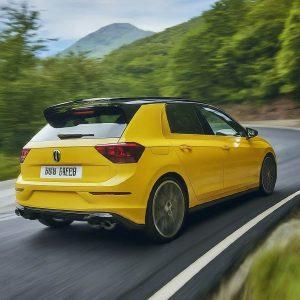Hatchbacks and station wagons share similar designs, featuring a two-box layout that combines passenger and cargo space into one area, along with five doors and seating for up to five people. However, distinguishing between them can be tricky due to overlapping features in modern car design, which blur lines between different body types like crossovers and SUVs. Explore the specific wagon vs. hatchback differences to help clarify their classifications.

Hatchback
The Obvious Difference Between a Hatchback and Wagon
To give you some background, station wagons and sedans usually share the same base structure. This makes it simpler for car manufacturers to produce them because they don’t need to create a whole new structure. However, some companies choose to develop unique platforms for these vehicles. This also means that the height of the roof and how far the car is from the ground are usually the same for station wagons, hatchbacks, and sedans.
The main visible contrast between station wagons and hatchbacks is often their lengths. Wagons are usually longer than hatchbacks, which gives them more space inside for carrying stuff and for seating. However, just looking at their length isn’t always the best way to tell them apart from each other, as we’ll see in the next few points.
Body Style
A hatchback is like a medium-sized car that has a back door which opens up with both the window and trunk together. When you open this back door, you can get to the space behind the back seats where you can put things. On the other hand, a station wagon is a bigger car with longer wheels and a larger overall size. This is the main way we can tell them apart. For example, the VW Golf, which is a hatchback that a lot of people like, has a wheelbase of 103 inches. But the Volvo V60, which is a station wagon, has a longer wheelbase of 113 inches.
Number of Windows
One more way to spot the difference between a hatchback and a station wagon is by counting the windows. Usually, what makes a hatchback a hatchback are two sets of windows—one in the front and one in the back. But a station wagon usually has at least three sets, with the extra pair often behind the back seats. Still, there are some hatchbacks out there with three pairs of windows, so it’s not always a surefire way to tell. Let’s move on to the next part.

Station Wagon
How Many Pillars Are There?
Besides looking at the windows, you can also figure out if a car is a station wagon or a hatchback by checking its pillars. A regular hatchback usually has A, B, and C pillars, while a station wagon will have an extra D pillar at the back. Although this can be a good clue, remember that some hatchbacks might have more than two sets of windows at the back. So, there’s another way to distinguish between them, which we’ll discuss next.
Hatchback vs. Station Wagon: Rooflines and Rear Bumper
The first three ways we talked about before are still good ways to tell if a car is a hatchback or a station wagon. But nowadays, car designs can make it a bit confusing. For instance, a newer Honda Jazz had more windows and pillars than usual for a hatchback, even though it’s still called a hatchback. This makes it trickier to tell it apart from a station wagon. But there’s another way that might be more helpful: look at the rooflines.
Hatchbacks usually have roofs that slope down right after the back doors, while station wagons have roofs that keep going past the back door. To put it simply, the back pillar of a hatchback is often right on top of the back wheel, making the back of the car short. But in a station wagon, that pillar is farther back, so the back of the car is longer than in a hatchback. If you use all these tips together, it should be easier to tell if it’s a hatchback or a station wagon.
Styling
Hatchbacks and station wagons look a lot alike outside, but they have some differences. Take the Suzuki Swift, for example, a hatchback. It has two sets of windows—one in the front and one in the back. But a station wagon, like the Dodge Magnum, has three sets of windows. Also, they’re different when it comes to the pillars. Hatchbacks have A, B, and C pillars, while station wagons have an extra D pillar, which makes them look longer.
Cargo Space
Hatchbacks are smaller than station wagons and have a shape that’s good for using space efficiently. You can fold down the back seats in a hatchback to make more room for carrying stuff. Station wagons are bigger and have a squarer shape in the back, which makes them great for carrying lots of cargo. They have more space for bigger things, which can be really handy for families or people who need to haul a lot of stuff often. When it comes to how much stuff they can hold, station wagons usually win. For example, a Mini Cooper can hold up to 246 liters of stuff, while a Subaru Outback can hold a lot more—923 liters!
Performance and Handling
Hatchbacks are smaller and lighter, so they usually handle turns and curves better and use less fuel. On the other hand, station wagons are bigger, so they might not be as quick to turn, but they often give a smoother ride and more comfort, especially on long trips.
Hatchback or Wagon? Know Before You Buy
To sum up, whether you’re deciding between a hatchback or a station wagon, it’s essential to consider their key differences: the body style, the number of windows and pillars, rooflines, and cargo space. While they may share some similarities, such as seating capacity and overall layout, these distinctions can help you make the right choice for your needs. So, next time you’re in the market for a new car, take a closer look at these factors to ensure you select the perfect vehicle for you and your lifestyle.
